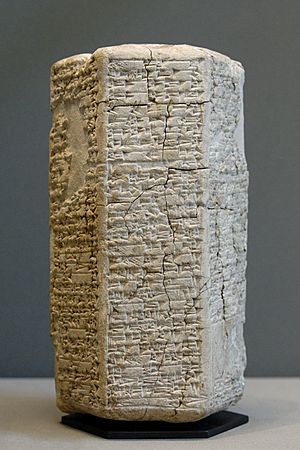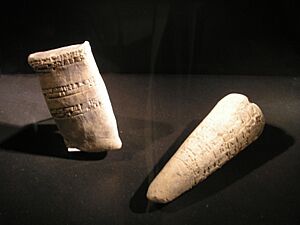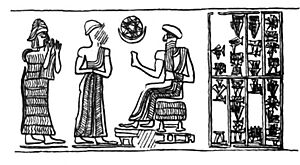Isin facts for kids
| [[File::None at this time|frameless]] | |
| Alternative name | Ishan al-Bahriyat |
|---|---|
| Location | Al-Qādisiyyah Governorate, Iraq |
| Region | Mesopotamia |
| Coordinates | 31°53′06″N 45°16′07″E / 31.88500°N 45.26861°E |
| Type | Settlement |
| History | |
| Periods | Early Dynastic, Isin-Larsa, Old Babylonian, Kassite, Neo-Babylonian |
| Site notes | |
| Excavation dates | 1924, 1926, 1973-1989 |
| Archaeologists | Stephen Herbert Langdon, Raymond P. Dougherty, Barthel Hrouda |
Isin is an archaeological site in Al-Qādisiyyah Governorate, Iraq which was the location of the Ancient Near East city of Isin, occupied from the late 4th millennium Uruk period up until at least the late 1st millennium BC Neo-Babylonian period. It lies about 40 km (25 mi) southeast of the modern city of Al Diwaniyah.
The tutelary deity of Isin, dating back to at least the Early Dynastic period, was the healing goddess Gula with a major temple (, E-gal-ma) sited there as well as smaller installations for the related gods of Ninisina and Sud.
Archaeology
Isin is located approximately 20 miles (32 km) south of the ancient city of Nippur. The site covers an area of about 150 hectares with a maximum height of about 10 meters.
By 1922 the site had been suggested as that of Isin. Ishan al-Bahriyat was visited by Stephen Herbert Langdon for a day to conduct a sounding, while he was excavating at Kish in 1924. He found inscribed bricks of Ishme-Dagan and Enlil-bani. Two years later Raymond P. Dougherty, on behalf of the American Schools of Oriental Research, conducted a two-day survey of the site finding inscribed bricks of Bur-Sin and Neo-Babylonian ruler Nebuchadnezzar II.
Modern archaeological work at Isin was accomplished in 11 seasons between 1973 and 1989 by a team of German archaeologists led by Barthel Hrouda on behalf of the Munich Institute for Near Eastern Archaeology. Hundreds of cuneiform tablets from the Old Babylonian period, in buildings abandoned after being destroyed by fire, were recovered. However, as was the case at many sites in Iraq, research was interrupted by the Gulf War (1990–1991) and the Iraq War (2003 to 2011). Since the end of excavations, extensive looting is reported to have resumed at the site. Even when the German team began their work, the site had already been heavily looted. A significant find, in the Ninurta shrine of the Gula temple, was an alabaster mace head of the Akkadian Empire ruler Manishtushu inscribed "Man-istusu, king of the world, dedicated (this mace) to the goddess Ninisina". An inscription of Takil-ilissu, ruler of Malgium was also found. Early find included a Jemdet Nasr stamp seal and a small stone lion figurine of the Uruk period.
The primary focus of the excavations was the four meter wide wall enclosed Gula temple complex. The complex showed construction through at least the Isin I, Kassite, and Neo-Babylonian periods with 3rd millennium BC finds suggested its earlier existence. Finds included 30 dog burials, copper pendants inscribed with dog images, and clay dog figurines, one with a prayer to Gula. An inscribed brick of Adad-apla-iddina, 8th ruler of the 2nd dynasty of Isin, dedicated to the healing goddess Nin-ezena was also found. On another section of the main mound 3rd millennium BC buildings provided "gold jewellery, bronze weapons, cylinder seals, and a few cuneiform tablets of which two date back to the Early Dynastic period", a clay nail of Isme-Dagan referring to construction of the bad-gal "Great Wall" city wall of Isin and an inscribed brick of Ur-du-kuga. In the Kassite layer an Early Dynastic III statue, 16.5 cm in height, of a kneeling man wearing only a triple belt. Just to the south of the temple complex two Early Dynastic I period buildings were found.
History

The site of Isin was occupied at least as early as the Ubaid period based on pottery shards. Significant occupation began in the Early Dynastic period in early to middle 3rd millennium BC. Isin is known to have been occupied during the Akkadian Empire. An intensive building program began at Isin during the Ur III empire in the late 3rd millennium BC. WIth the fall of Ur, an Amorite dynasty took power in the city, during the Isin-Larsa period. The city then fell to Babylon and suffered a period of abandonment. Activity resumed under the Kassites, followed by a period of local control. Isin was occupied to various degrees until the Neo-Babylonian period.
With the final decline of the Ur III empire at the end of the third millennium BC, a power vacuum was left that other city-states scrambled to fill. Ishbi-Erra, said to be an Amorite, from Mari, and an Ur III official under its final ruler Ibbi-Sin, gained rulership of Isin and began the First Dynasty of Isin. The Elamites had attacked Isin and Ur, capturing Ur. One of Ishbi-Erra's acts was to expel the Elamites from Ur and the region, his year name being "Year (Iszbi-Irra the king) brought out of Ur, with his strong weapon, the Elamite who was dwelling in its midst". Although the Sumerian King List gives a 33-year reign for Ishbi-Erra only one royal inscription has been found.
"For the god Enlil, lord of the foreign lands, his lord, Isbi-Err[a], mighty king, lord of <his> land, fashioned a great lyre for him, which ... the heart. He dedicated it [for his own] life. The name of this lyre is 'Isbi-Erra trusts in the god Enlil'."
The Isin I dynasty lasted over two centuries. Its most powerful period was early on. With the rise of Larsa and a number of smaller Amorite city-states, the influence of Isin slowly declined. A notable ruler was Ishme-Dagan for whom a number of hymns were written, in a style thought to be imitative of Shulgi, the ruler of Ur III.
The exact events surrounding Isin's disintegration as a kingdom are mostly unknown, but some evidence can be pieced together. Documents indicate that access to water sources presented a huge problem for Isin. Isin also endured an internal coup of a sort when Gungunum the royally appointed governor of Larsa and Lagash province, seized the city of Ur. Ur had been the main center of the Gulf trade; thus this move economically devastated Isin. Additionally, Gungunum's two successors Abisare and Sumuel (c. 1905 BC and 1894 BC) both sought to cut Isin off from its canals by rerouting them into Larsa. At some point, Nippur was also lost. Isin would never recover. Around 1860 BC, an outsider named Enlil-bani seized the throne of Isin, ending the hereditary dynasty established by Ishbi-Erra over 150 years earlier.
Although politically and economically weak, Isin maintained its independence from Larsa for at least another forty years, ultimately succumbing to Larsa's ruler Rim-Sin I.
After the First Dynasty of Babylon rose to power in the early 2nd millennium and captured Larsa, much significant construction occurred at Isin. This ended with a destruction dated to around the 27th year of the reign of Samsu-iluna, son of Hammurabi, based on tablets found there.
Later, the Kassites who took over in Babylon after its sack in 1531 BC, resumed building at Isin. Activity was primarily at the Gula temple and it appears that in that period Isin was only a cult center. The final significant stage of activity occurred during the Second Dynasty of Isin at the end of the 2nd millennium, most notably by king Adad-apla-iddina. Isin remained occupied at least as late as the second decade of the reign of the Persian ruler Darius I (c 507 BC), then in the control of the region.
Of the at least 256 ruler year names about 75% have been found. Most have the standard format, aside from Bur-Sin who numbered his years. These year names combined with new tablet joins show that there were two additional rulers, Sumu-abum and Ikūn-pī-Išta, slotting in between Erra-imittī and Enlil-bān. The reign of Sumu-abum lasted less than a year.
List of rulers
| Portrait or inscription | Ruler | Approx. dates of reigns (Middle Chronology) | Comments, notes, and references for mentions |
|---|---|---|---|
| First dynasty of Isin (c. 2018 – c. 1791 BC) | |||
| Ishbi-Erra | r. c. 2018 – c. 1985 BC | temp. of Ibbi-Suen of Ur III | |
| Shu-Ilishu | r. c. 1985 – c. 1975 | Son of Ishbi-Erra | |
| Iddin-Dagan | r. c. 1975 – c. 1954 | Son of Shu-Ilishu | |
| Ishme-Dagan | r. c. 1954 – c. 1935 | Son of Iddin-Dagan | |
| Lipit-Ishtar | r. c. 1935 – c. 1924 | temp. of Gungunum of Larsa | |
| Ur-Ninurta | r. c. 1924 – c. 1896 | temp. of Abisare of Larsa | |
| Bur-Suen | r. c. 1896 – c. 1874 | Son of Ur-Ninurta | |
| Lipit-Enlil | r. c. 1873 – c. 1869 | Son of Bur-Suen | |
| Erra-imitti | r. c. 1869 – c. 1861 | ||
| Ikūn-pî-Ištar | r. c. 1861 – c. 1860 | ||
| Enlil-bani | r. c. 1860 – c. 1837 | temp. of Sumu-la-El of Babylon | |
| Zambiya | r. c. 1837 – c. 1834 | temp. of Sin-Iqisham of Larsa | |
| Iter-pisha | r. c. 1834 – c. 1831 | ||
| Ur-du-kuga | r. c. 1831 – c. 1828 | ||
| Suen-magir | r. c. 1827 – c. 1816 | ||
| Damiq-ilishu | r. c. 1815 – c. 1791 | Son of Suen-magir | |
| Portrait or inscription | Ruler | Approx. dates of reigns (Middle Chronology) | Comments, notes, and references for mentions |
| First Sealand dynasty (c. 1732 – c. 1475 BC) | |||
| Ilum-ma-ili | r. c. 1732 – c. 1700 | Relative of Damiq-ilishu (?) | |
| Ittili | r. c. 1700 – c. 1683 | ||
| Unknown | r. c. 1683 – c. 1677 | ||
| Damqi-ilishu II | r. c. 1677 – c. 1642 | ||
| Ishkibal | r. c. 1641 – c. 1617 | ||
| Shushushi | r. c. 1617 – c. 1599 | Brother of Ishkibal | |
| Gulkishar | |||
| Gishen | |||
| Peshgaldaramesh | r. c. 1599 – c. 1549 | Brother of Gulkishar | |
| Ayadaragalama | r. c. 1548 – c. 1520 | Brother of Peshgaldaramesh | |
| Ekurul | r. c. 1519 – c. 1493 | ||
| Melamma | r. c. 1492 – c. 1485 | ||
| Eaga | r. c. 1484 – c. 1475 | ||
| Portrait or inscription | Ruler | Approx. dates of reigns (Middle Chronology) | Comments, notes, and references for mentions |
| Second dynasty of Isin (c. 1153 – c. 1022 BC) | |||
| Marduk-kabit-ahheshu | r. c. 1153 – c. 1135 | ||
| Itti-Marduk-balatu | r. c. 1135 – c. 1129 | Son of Marduk-kabit-ahheshu | |
| Ninurta-nadin-shumi | r. c. 1129 – c. 1122 | ||
| Nebuchadnezzar I | r. c. 1122 – c. 1100 | ||
| Enlil-nadin-apli | r. c. 1100 – c. 1096 | ||
| Marduk-nadin-ahhe | r. c. 1096 – c. 1078 | ||
| Marduk-shapik-zeri | r. c. 1078 – c. 1065 | ||
| Adad-apla-iddina | r. c. 1065 – c. 1061 | ||
| Marduk-ahhe-eriba | r. c. 1061 – c. 1041 | ||
| Marduk-zer-X | r. c. 1041 – c. 1029 | ||
| Nabu-shum-libur | r. c. 1029 – c. 1022 | ||
Culture and literature
The city lay on the Isinnitum Canal, part of a set of waterways that connected the cities of Mesopotamia. The patron deity of Isin was Nintinuga (Gula) goddess of healing, and a temple to her was built there. The Isin king Enlil-bani reported building a temple to Gula named E-ni-dub-bi, a temple for Sud named E-dim-gal-an-na, a temple E-ur-gi-ra to Ninisina, as well as a temple for the god Ninbgal.
Ishbi-Erra continued many of the cultic practices that had flourished in the preceding Ur III period aiming to strengthen the king's relationship to the gods, which would then bring stability and prosperity on the entire country.
The Isin kings continued also the practice of appointing their daughters official priestesses of the moon god of Ur.
The literature of the period also continued in the line of the Ur III traditions when the Isin dynasty was first begun. For example, the royal hymn, a genre started in the preceding millennium, was continued. Many royal hymns written for the Isin rulers mirrored the themes, structure, and language of the Ur ones. Sometimes the hymns were written in the first person of a king's voice; other times, they were pleas of ordinary citizens meant for the ears of a king (sometimes an already dead one).
It was during this period that the Sumerian King List attained its final form, though it used many much earlier sources. The very compilation of the List seems to lead up to the Isin Dynasty itself, which would give it much legitimacy in the minds of the people because the dynasty would then be linked to earlier (albeit sometimes legendary) kings.
See also
- Cities of the Ancient Near East
- List of Mesopotamian dynasties





